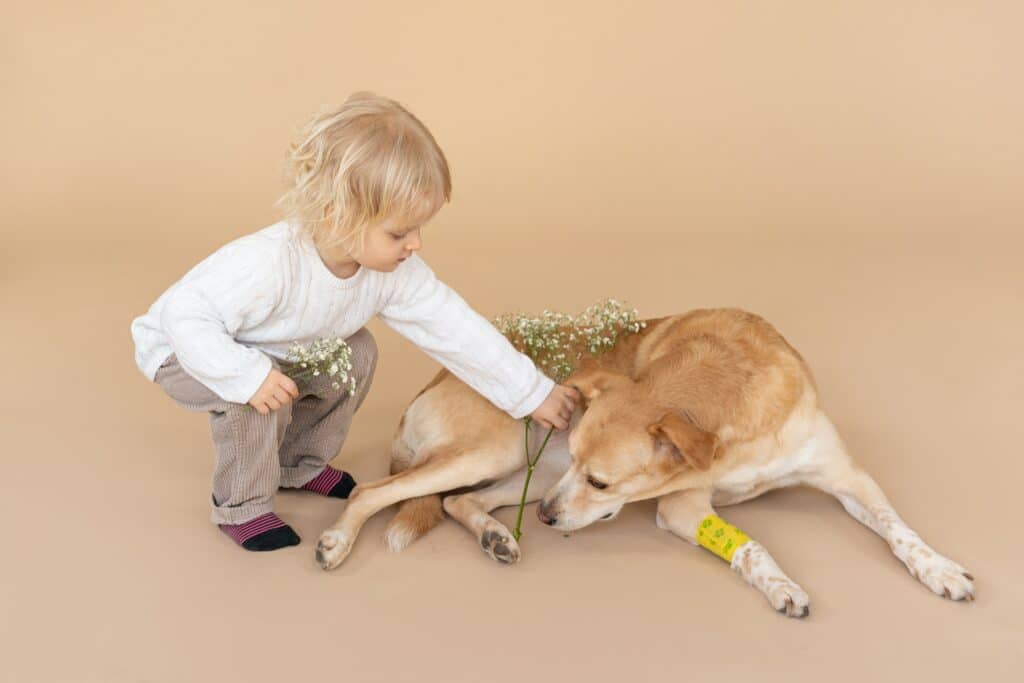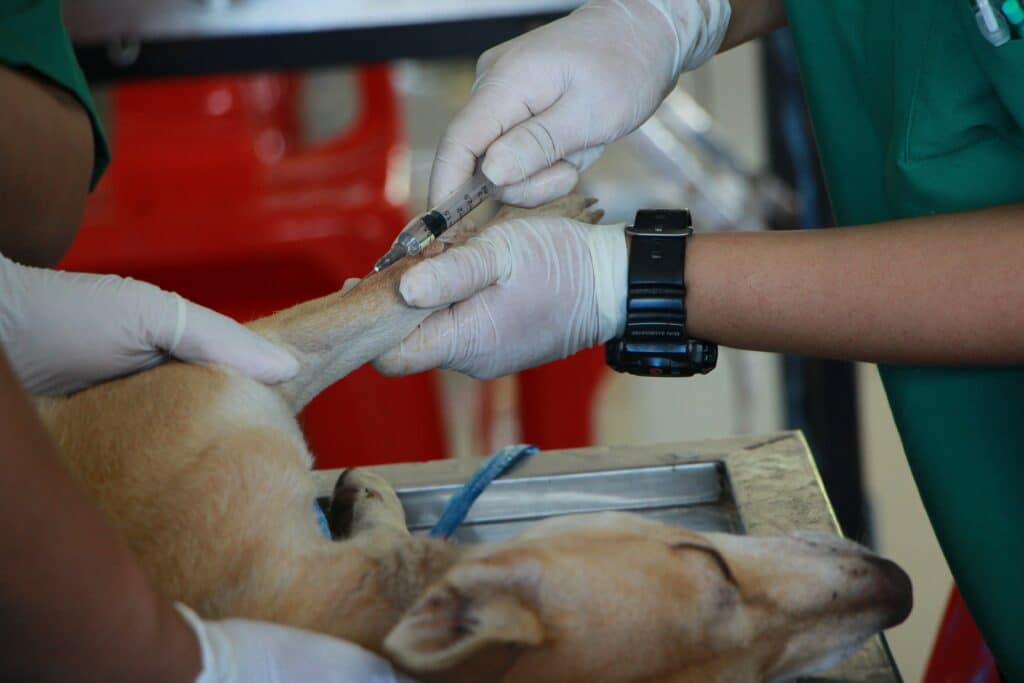We're an affiliate
We hope you love the products we recommend! Just so you know, we may collect a share of sales or other compensation from the links on this page at no additional cost to you. Thank you if you use our links, we really appreciate it!
Arthritis is a prevalent health problem that affects humans and dogs alike. It is estimated that close to 20% of dogs in America over 1-year-old have shown some form of arthritis.
This joint problem is characterized by inflammation of the joints which can lead to other issues including mild to severe pain, decreased mobility, and stiffness during walks.
Arthritis can affect dogs of all ages but it is more prevalent in older and large-breed dogs who place a lot of stress on their joints.
It is essential for all pet parents to know about arthritis in dogs, how they get it, the early signs, and how you can manage it to help your doggo live comfortably if affected.
We invite you to keep reading this post to find out all the bits and pieces that you need to know to ensure you are in a safe place to take care of your canine companion.
How Do Dogs Get Arthritis?
Osteoarthritis (OA), which is the most common form of canine arthritis, is a degenerative disorder that results from the progressive wearing and tearing of the cartilage.
Any joint in the dog’s body can suffer from this condition but it is more prevalent in the limbs and spinal column.
Cartilage is a tough tissue that provides cushion to the joints to allow flexible and smooth movement during motion.
Dogs get arthritis when the cartilage undergoes progressing wear and tear hence failing to provide the needed cushioning during motion.
Without this padded shield, the affected dog will have an inflamed joint with pain, bone spurs, and discomfort during movements.

Rheumatoid arthritis is a very rare form of an autoimmune disorder that commonly affects toy-breed dogs.
This condition comes about when the dog’s immune system attacks its own joints leading to inflammation and progressive damage to the joints.
Dogs’ can suffer Septic arthritis when their joints get infected by bacteria or other harmful germs. The most common bacteria that causes this condition is Staphylococcus Aureus (Staph).
Such pathogens would normally find their way into the dog’s joint through physical injuries on the joint areas.
Despite the main causes of arthritis in dogs, other factors can influence the progression of this disorder in dogs. They are;
- Weight
- Underlying health conditions.
- Age
- Nutrition
- Injuries
- Genetics
What Age Do Dogs Usually Get Arthritis?
It is a commonly held belief that osteoarthritis can only affect senior dogs. Surprisingly enough, even younger pups can acquire this condition from the tender age of 1 year.
This leaves pet parents with the responsibility of observing their dog’s condition regularly and making frequent visits to the vet for wellness checkups.
Most dogs are however at risk of developing a form of arthritis from their 8th birthday onwards. Most severe conditions are recorded for canines who have attained this age but you should always be on the lookout.

You need to know what to give senior dogs for arthritis to help your affected dog live a comfortable and quality life without limited mobility.
Large breed dogs and giant breeds have a higher predisposition to get arthritis compared to small and medium-sized ones. This is because of the much strain that is placed on their joints from their body mass.
What Are the First Signs of Arthritis in Dogs?
Most people always look for severe signs like limping when examining whether their dogs have an inflamed joint or not.
When your dog finally limbs because of arthritis, then the condition might have already taken a toll on them and they cannot hide it anymore.
Knowing arthritis in dogs may not be easy if you look out for severe signs and symptoms. A simple reluctance to jump should inform you that your pup is trying to avoid something due to pain or fear.
Many other telltale signs should inform you about your dog’s degenerating joint(s) during its early stages. The following are some of the most common that you should look out for:
- The dog becomes reluctant to walk as they used to before.
- Unusual gait or walking sideways.
- Unwillingness to use the stairs. (Get a ramp instead!)
- Stiffness during walks.
- Yelping when straining to walk.
- Yelping when touched on the joints.
- Reduced runs and plays.
- Unexplained weight gain and muscle loss.
- Kicking out the affected legs into the air.
- An abrupt behavior changes. The dog might become aggressive towards you and other pets alike.
- Licking or chewing one or more joint areas.
- Lameness and limping.
If you notice any of the signs that tell your dog is not well, it is important that you visit the vet for a wellness check-up and examination.
The vet will diagnose and rule out other medical conditions before prescribing the best treatment for your pup.
Knowing this progressive disorder early and managing it will enable your pup to live a good life despite having degenerative joints.
Do Dogs Feel Pain with Arthritis?
Affected dogs will feel the pinch of arthritis on their joints and the pain varies depending on how severe the condition is.
The wear and tear in arthritis causes the joints’ structure to change and this might reduce the cushion hence making the bones grind against each other.
The friction incurred during walking and movements is what will make your dog feel the pain of suffering from this condition.

Severe cases of arthritis can be incredibly painful for your dog and as such, they may incur stiffness and lameness which can make things worse if not properly managed.
With proper care and management, you can help your affected dog from feeling too much pain from an arthritic joint.
How Can I Prevent My Dog from Getting Arthritis?
There is no one sure thing that you can do to completely prevent your furry friend from ever becoming arthritic.
In fact, some form of arthritis is genetically predisposed, and it could happen that your pup is unlucky to carry certain genes.
But don’t fret about that because there are some things that you can do to help prevent this condition from developing early or reaching severe stages.
Some of the steps that you can take are;
1. Weight management
You can play a part in preventing your dog from developing degenerative arthritis by helping them to maintain a lean body right from puppyhood.
Do this by adopting a proper nutrition guideline with a workable feeding program that gives your dog the right nutrients for optimal growth.
It has been shown that lean dogs are less likely to become arthritic and they also live a longer and healthier life than overweight ones.
2. Regular exercises
Providing your doggo with light exercises is a great way to ensure that they maintain a healthy body with flexible joints.
A simple morning walk and evening runs are enough to stimulate your dog’s body and mind to build some muscles in their lean bodies.
Be careful not to over-involve your dog in very intensive activities. Heavy exercises might put a toll on your dog’s body and especially the joints, hence making it even worse for them.
3. Healthy & balanced diet
Nothing beats a healthy diet when it comes to giving our furry pets the quality of life they deserve. Diet is more than satisfying the sweet tooth of the pets, it goes down deep to ensure they receive the required nutrients and minerals for their optimal health.
A balanced diet for your dog should contain measured servings of proteins, carbs, vitamins, and minerals without forgetting some clean drinking water to make it complete.
You should also be careful not to overfeed your dog because they could add too much weight and that is what we initially want to avoid.
Add some fiber-rich foods to their daily food intake to make sure they become satisfied with their recommended servings. Fiber will also aid in digestion and ensure the dog absorbs all the nutrients they ingested.
4. Protect your dog from physical injuries
Injuries on your dog’s joint(s) could also make them develop inflammation which could lead to arthritis.
It is important that you protect your doggo from intense physical activities that could predispose them to get injured.
Discourage your dog from jumping too high from raised platforms or getting too energized during their exercises. This could put too much stress on their joints and it could just make things worse for them.
Show your dog that you love it when they use their car ramps or stairs when getting into and out of the vehicle during your round trip to the vet.
Can Arthritis in Dogs Be Cured?
There is really no known cure for arthritis in dogs but with proper veterinary care, this condition can be managed to make your dog move comfortably.
Your vet should prescribe a treatment plan that should cushion your dog’s joints from wearing down further. This should also work to reduce inflammation and make Fido walk without straining too much.

The vet can recommend Nonsteroidal anti-inflammatory drugs (NSAIDs) to reduce the pain and irritation in your dog’s joints.
These drugs may not be effective on all dogs and you might be required to use other pain-relieving medication to alleviate your pup’s joint pain.
Make sure you do this with a prescription from your vet otherwise giving the wrong dosage might harm your pup.
There are several joint supplements for dogs that you can use to help mend your dog’s distorted cartilage.
These supplements are formulated with the biological components (glucosamine, chondroitin, and Green Lipped Mussel) that are naturally found in the dog’s cartilage.
These supplements can be found in stores and they are in various forms including treats, powders, and tablets.
If your dog is having severe cases of arthritis, your vet might recommend hip replacement, joint fusion, or excision arthroplasty surgery to repair the affected joint(s) and insert artificial joint implants.
Keep in mind that surgical treatment will not return your dog’s joints to normal health but will help them reduce the pain and discomfort.
Best Supplements for Arthritis in Dogs
One of the most convenient and safe ways to manage your arthritic dog at home is to provide them with joint supplements. They help to reduce pain and improve the working of your dog’s cartilage.
These supplements are also good to prevent your dog from rapidly progressing toward the adverse effects of joint inflammation.

We, therefore, recommend that you start your dog early enough on supplements to ensure their joint issues are taken care of from start.
We have compiled a list of the best hip and joint supplements for dogs, make sure you check it out!
What To Look for In a Good Joint Supplement for Dogs
When shopping for the best supplements for arthritic dogs, you should always look for products that have certain qualities that will help out.
1. Ingredients
Look for the products that have been made with the naturally occurring compounds found in the dog’s cartilage and joints. The most common ones are glucosamine and chondroitin but don’t be limited to those two only.
Watch out for other ingredients such as omega-3 fatty acids and green-lipped mussel that will all work together to cushion your dog’s degenerative joints.
Make sure to choose the products with the required levels of these ingredients to guarantee their effectiveness.
2. Form of the supplement
Most dogs will appreciate a supplement that comes in the form of yummy treats or juicy chews. These forms are the most popular way of giving your dog something nice.
You need to consider your dog’s personality and examine what will work out for them before deciding on the product to buy.
If your dog has a sweet tooth, make sure to choose the ones made with their favorite tastes and smells.
Some supplements are formulated in powder form and others are in small pills. If you must do pills, we recommend going for those that have been hidden in a tasty food bite. This will motivate your dog to chew more.
Remember to seek advice from your veterinarian before starting your canine friend on any supplement. They should guide you on the best dosage based on your dog’s size and breed.
In Conclusion
Arthritis in dogs has become a common disease that should get attention from all pet parents. Don’t wait until you see your dog limping before taking action.
While it is true that there is no known cure for arthritis, there are a few things you can do to help your dog move comfortably without pain.
Check on what helps dog joints and see how you can help your canine friend to have healthy joints.
Make sure to work on a program with your vet to know the best arthritis management plan for your furry friend.
Laura is the founder of Furs'n'Paws. She is a also a pet writer and expert with more than 20 years of experience of working with dogs and cats. She developed a very strong love for animals at a young age. Her passion led her to establish a thriving pet sitting and dog walking business in Dubai. As an expert in pet training, behavior, and nutrition, Laura is committed to helping pet owners and pet lovers by offering high-quality information on a wide range of topics.



No responses yet